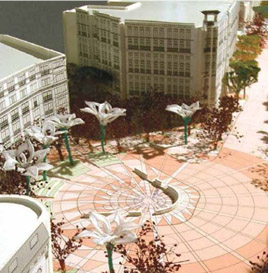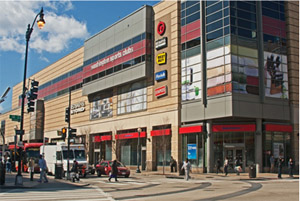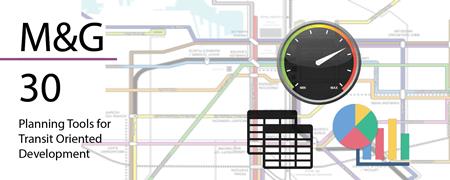Building Diversified Communities
Best practice: Columbia Heights Benefits from Good Design, Affordability

Planners elevated public space, often an afterthought, to the defining element of Columbia Heights
A historic, ethnically and socially diverse neighborhood left in near ruin by the 1968 riots, Columbia Heights today shines as a lively and accessible place to live, work, shop and play. The community benefits tremendously from the Green Line metro station that opened in 1999, as well as bus and bicycle routes.
Yet, even with the cachet that has accompanied the redevelopment of what is now clearly a hip neighborhood, Columbia Heights serves as a model for providing affordable housing, filling a need that is often overlooked in similar projects.
Columbia Heights’ integration of housing, retail, offices and the arts creates a solid foundation for a vibrant community, one made even more interesting and diverse thanks to a blend of national and local retailers and affordable and market-rate dwellings. This mix of uses provides people with places to go on foot, but additional design features elevate Columbia Heights from a series of mixed-use development projects near a metro station to a remarkable, cohesive urban space.
Recognizing the opportunity to capitalize on the newly opened Columbia Heights metro station with new transit-oriented development, the Washington, D.C., Office of Planning (DCOP) worked in partnership with the Department of Transportation, Office of Economic Development, National Capital Revitalization Corporation, Arts and Humanities Commission, artists and an advisory committee to craft the 2004 Columbia Heights Public Realm Framework Plan. With this plan, DCOP elevated public space, often an afterthought, to the defining element of Columbia Heights. As a result, the public space today serves as the heart of the community, creates value for surrounding real estate, provides an amenity for the residents and has become an economic driver that invites people to patronize nearby businesses.
Columbia Heights boasts two well-defined and popular public plazas, as well as wide sidewalks lined by shops and restaurants. Even subtle details, like the way the building façades provide a distinct edge to the street, make a huge difference in how people experience the space. In Columbia Heights, the plazas feel more like fun outdoor rooms than empty voids. When people care about a place, as many Columbia Heights residents, business owners, employees and visitors do, they help keep it safe and clean, contributing to a sense of pride in the community.

Columbia Heights big box retailers have gone vertical with structured parking invisible to the streetscape
In many transit-oriented developments, accommodating parking and large retailers often poses a challenge. Parking and large footprint buildings, unless lined by smaller storefronts, can interrupt the urban fabric with blank walls and single purpose uses, making it less likely that people will walk – and, therefore, use transit. While Columbia Heights accommodates big box stores and plenty of parking (though at a ratio less than typically required by national retailers), it does so without sacrificing its cool urban ambiance and walkability. People who arrive by car park underground or in garages hidden behind buildings, and retailers have fit their big box stores into multiple stories.
Since 2000, developers have built hundreds of apartments and condominiums, hundreds of thousands of square feet of retail and office space, and restored a historic theater. The new development, despite having a density greater than the surrounding historic neighborhoods, blends in well with its surroundings in part due to the human scale and massing of the buildings and in part to the buildings’ timeless architecture, which takes its cues from historic buildings in the neighborhood.
Despite its tremendous popularity and pricey real estate, Columbia Heights remains a relatively affordable, diverse community thanks to the foresight of community leaders, elected officials, planners, and others. The zip code in which Columbia Heights is located experienced one of the largest appreciations in property value between 2000 and 2007 (279 percent) and one of the lowest declines during the recession (-9.7 percent). Despite this, 18 percent of the housing units within a half-mile of the Columbia Heights metro station are considered affordable. Since the metro station opened in 1998, developers have built 1,697 units, of which 596 are affordable. Similarly, 1,542 units have been rehabbed since 1998; 1,476 of those units are affordable.
Washington, D.C., used two tools to retain and produce affordable housing in Columbia Heights. Recognizing the opportunity generated by the metro station opening and increased developer interest in Columbia Heights, as well as the looming expiration of affordable housing projects, the city designated Columbia Heights as one of several Strategic Neighborhood Investment Plan (“SNIP”) areas. When reviewing applications for public resources such as Community Development Block Grants, the Department of Housing & Community Development awarded bonus points to projects with affordable housing components. This policy helped to preserve affordable housing and encouraged renovation of more than 1,400 low-income units in the area. In addition, city officials required the provision of affordable housing in any future residential development on nine city-owned parcels in the neighborhood. Most of the new residential buildings incorporate a mix of market rate and affordable housing units, but Victory Heights, a building of 75 units, is reserved exclusively for low-income seniors. The affordable units created through these policies will remain affordable for 20 to 40 years, depending on sources of funding and land disposition agreements.
The city also employed a third tool: acquiring many residential buildings, primarily single-family homes, through tax liens, then bundling them for sale to developers with a 30-percent affordable rate requirement.
The Columbia Heights development boom occurred prior to the enactment of Washington, D.C.’s, inclusionary zoning law. Today, development of new rental or condominium buildings with more than 10 units must include a percentage of affordable units in exchange for a density bonus; this also applies to renovations of rental or condominium buildings that increase building size by more than 50 percent. Washington also has a number of other programs designed to maintain affordability, which are applicable throughout the city, such as the Tenant Right to Purchase Act, the District Right to Purchase Act, Rent Control, the Housing Production Trust Fund, Housing Assistance Program, and Affordable Dwelling Units.
TOD Best Practices: Building Diversified Communities
